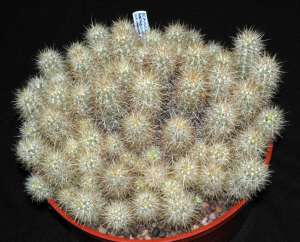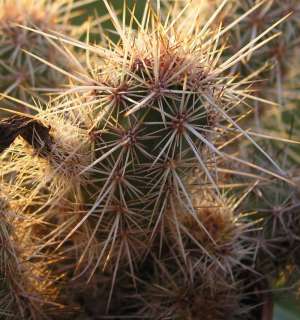|
2006 - A
Baja Echinocereus year Ian
Priestley |
Part 1
Introduction
I first became interested in Baja
Echinocereus many years ago, in line with my enthusiasm for the Mammillaria
species of Baja California, which have fascinated me for more years than I care
to publish! I have gradually acquired a variety of these Echinocereus plants
over time, and fortunately, most have managed to survive (despite?) my
rudimentary cultivation techniques, a strong pointer to their relative ease in
cultivation, given reasonable conditions.
I was also encouraged to expand
my collection and search for plant material by an article written by Robin
Alabaster, long ago in Cactus File, Volume 2, Number 2 (August 1994), where he
talked about his experiences cultivating a trio of species, E. grandis, E.
websterianus and E. scopulorum.
Since our house move to Bedford
in May 2004, we have had some particular successes with some of these Baja
California Echinocereus species. This is a bonus that I put down to the
increased light levels and recent very warm weather conditions that we are
receiving. For those who know my collection, many of the plants mentioned below
now reside on the LHS top shelf of the main greenhouse, situated so as to
capture the max heat/sunlight during the day, a situation in which they seem to
flourish.
Some of these plants have a
history of being difficult to flower in the UK, but I suspect that most,
(perhaps excepting E. barthelowanus???), given appropriate warm, bright
summer conditions, may prove to be no different from other Baja Californian
plants, which appear reasonably easy to flower in cultivation, given appropriate
care, not too much water and bright, sunny conditions.
Many of these Echinocereus
species– see below, are rare in cultivation, at least in the UK. They are
though probably more plentiful in Europe, particularly I suspect in Germany,
where the genus is very popular and where I have personally seen some striking
plants in collections. That said, it is unclear how much actual material is ex
habitat plant/seed propagations, there do seem to be some impostors or is that
just mis-labelling?
Reference books
Unusually, there are a number of
very fine reference books on these plants, particularly;
1. Frank, Ohr and Romer – Die
Echinocereen der Baja California 2001
2. Blum, Lange, Rischer and Rutow
– Echinocereus 1998.
3. Taylor, Nigel P. The genus
Echinocereus 1985
4. Martino, Lino Di
(Editor) Cactus & Co Echinocereus Special Edition 1996
5. Anderson – The Cactus
Family.
plus of course, the two new
Cactus Lexicon volumes.
Moreover, for those who like to
check their plants against type locality photographs, then I wholeheartedly
recommend Richard and Francesca Wolf’s magnificent opus on Baja California and
its islands (Baja California und seine Inseln). This was produced in alliance
with the German Mammillaria Society, so Mammillarias are a main focus but it
also contains many fine habitat pictures on Echinocereus.
There are also two online
references which are stuffed full of pictures and information
Echinocereus
Online in German and English
Echinocereus.com
in German
Echinocereus Species of Baja
I should define the scope of
these articles. How many Echinocereus species are there in the Baja Californian
region?
Well, I think the following list
of 13 species / sub-species is generally accepted. They certainly all appear in
the recent Cactus Lexicon, which I believe is a highly appropriate (and timely)
reference point.
-
E.
barthelowanus
-
E.
brandegeei
-
E.
engelmannii (v. munzii.)
-
E
ferreirianus
-
E.
grandis
-
E.
lindsayi = ferreirianus ssp. lindsayi
-
E.
maritimus
-
E.
maritimus v hancockii = E. maritimus ssp. hancockii
-
E.
mombergerianus (= polyacanthus ssp. pacificus in CITES)
-
E.
pacificus ( = polyacanthus ssp. pacificus in CITES)
-
E.
pensilis
-
E.
sciurus
-
E.
websterianus
To reduce the risk of discussing
only 13 (unlucky!) species, there is one other possibility for contention here, E.
scopulorum. This originates from Isla Tiburon, in the Gulf of Mexico.
Although I had this as a seedling plant many years ago, it unfortunately has not
survived the various difficulties that have beset our collection and I have yet
to obtain fresh material. It is another uncommon species in cultivation and may
be more allied with the species from mainland Mexico, although it is in a
similar situation to E. websterianus and some others, in residing on an
island, situated between BC and mainland Mexico.
Taking the species in
alphabetical order, I will begin with a personal favourite.
Echinocereus barthelowanus
I have three forms of this plant,
two fit the photographs of conventional plants, the third being a plant I
acquired, (in flower too! – see photographs) from two which were on sale at
ELK in 2006, by a German nurseryman. Although the purple flower fits the type
photographs I have seen, the plant body looks like E. barthelowanus, but
is thicker, resembling a E. maritimus form, (this is yellow flowered,
of
course). I am yet unsure whether this is the different form, which is apparently
attributed to De Herdt’s, nursery, but it does resemble some of the plants
shown in the habitat photos ex Wolf.
|

Barry Tibbett's
Echinocereus barthelowanus |
Of my original two forms,
the newest is one I obtained in Holland in 2000 with small, very neat and
tidy spination, which replaced an earlier similar plant, of 6” pan size,
which sadly and somewhat surprisingly rotted after about 15 years with me.
I also now have a smaller reserve plant, (repotted this year into a 7.5”
pan, after spending 2 years in a 6.3” pan), which I purchased in Holland
as a precaution, a few years ago.
My largest plant of this
form, has also been repotted earlier this year and now completely fills a
8.5” BEF pan. It too took two years to fill a 7” pan, when moved from
a 6” half pot, so it is a fairly quick grower, given suitable
conditions. It will also probably benefit from a larger home, possibly a
10” BEF pan, for 2007? Barry Tibbetts also has a large plant of this
form, which seems to match the photographs of the forms in cultivation all
of which appear to have originated from species ex the type locality –
the Isla Magdalena, Santa Maria Bay, BC, I refer to Preston-Mafham, Die
Echinocereen der Baja California” and “Echinocereus” in this regard.
It is also confirmed to grow on the nearby Isla Margarita and in both
locations shows considerable variability, both in the colour and size of
the joints/stems. |
|
My second form has much longer
central spination, giving it a rather untidy and “shaggier” look, it
was the one distributed by the ISI a few years ago under reference 98-03.
The relevant ISI notes say “this is a rare island endemic, related to
the widespread mainland species E. brandegeei. It differs in its
un-angled beige spines, which densely clothe the stems and which are a
translucent pinkish red when new”. This ISI offering originated from a
Reid Moran collection from the early 1960s at Santa Maria Bay, Isla de
Magdelena, BCS, one of the island habitats. This species flowered for us
in 2004, as the single flower remains will testify!!! However sadly and
extremely annoyingly - it managed to bloom whilst we were away on holiday
and I only spotted it afterwards!
As various commentators of the
genus have remarked this plant is exceptionally difficult to flower,
either in cultivation or in habitat. Nigel Taylor comments that it is a
very shy flowerer in the UK, although it has flowered in Germany, so this
was an extremely frustrating event!! |

Echinocereus barthelowanus ISI 98.03 |
I cannot recall ever having seen
it in flower elsewhere in the UK and I don’t think that Barry has managed to
flower his yet, although I think it is probably mature enough? Hence, I was
fervently hoping that it would repeat this activity again in 2005 and 2006,
especially as. The Priestley digital camera was consequently ready and poised,
but without success. Gosh, our plants can be annoying sometimes!
Cultivation wise, both forms do
seem reasonably easy, given the right conditions. They like bright, very hot
conditions, (in fact my second form only started into growth this year - I
noticed the growth tips had turned pinky-reddish, when the temperatures climbed
towards 100ºF – you have been warned!). Regular repotting and a light hand on
the watering can seem to help and “Prosper slowly” is good advice here,
replacements are hard to come by! This species does not have a deep root system
and seems to appreciate room to spread, so pan culture and plenty of grit is
also suggested, this also helps to prevent the soil becoming too waterlogged.
As to the flowers, well clearly
this plant is widely regarded as a very shy flowerer, even in habitat. I wonder
if maturity is a factor here, although this would seem to be unusual in
Echinocereus, but see my comments re E brandegeei. Anyway, there’s
always 2007 to look forward to and perhaps my new plant will oblige again,
forcing the others to follow its example!
Ian
In the next issue
Ian will discuss the remaining species and we might find room for some of the
Ed's habitat pictures.


